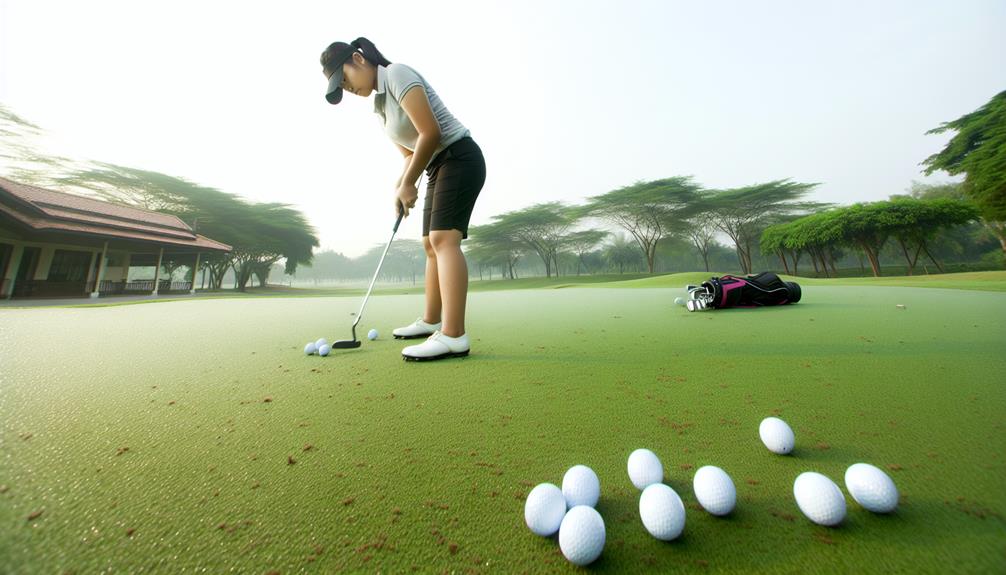Perfecting your putting prowess can be a pivotal part of your golf game, and with the right techniques, you can significantly streamline your strokes. You may think you've got your game down pat, but even the most seasoned players can benefit from a refresher on the basics and a look into the advanced techniques that professionals use.
With the right approach, you could shave strokes off your score and maybe even impress your golf buddies. So, what's the secret? Well, stick around, and you might just find out.
Understanding Golf Putting Basics
Before you can excel at golf putting, you'll need to grasp the basics, from the grip and stance, right down to the stroke mechanics. Your putter, the club you'll use the most in any game, should feel comfortable and natural in your hands. You can find putter selection tips everywhere, but remember, it's your game, and the best putter for you is the one that makes you feel confident.
Your grip is crucial. Hold the putter lightly. Too tight, and you'll limit your wrist action, too loose, and you'll lose control. Your stance should be balanced, with your eyes directly over the ball, giving you the best perspective for your stroke.
Now, let's talk about green reading strategies. Understanding the lay of the green is essential for predicting the path of the ball. Consider the speed, slope, and grain of the green. Your goal is to visualize the ball's path and adjust your stroke accordingly.
The Pro's Guide to Putting Drills
Once you've mastered the basics, it's time to dive into some professional putting drills that can really take your game to the next level. The key to becoming a top-notch putter lies in two elements: drill variations and mental focus.
Let's start with drill variations. The more diverse your practice, the better golfer you'll become. One popular drill is the 'Circle Drill'. You arrange balls in a circle around the hole and try to sink each one consecutively. This drill enhances your touch and stroke consistency.
Another is the 'Ladder Drill', where you putt balls at increasing distances from the hole. This develops your feel for distance control.
Now, let's talk about mental focus. In golf, your mental game is as important as your physical one. During practice, envision each putt as if it's the most crucial shot you've ever taken. This mindset will translate into your actual game, improving your performance under pressure.
Mastering Distance Control Techniques
While you're getting comfortable with various putting drills, it's essential to hone your distance control skills, as they can make or break your golf game. Mastering distance control involves two crucial factors: estimating green speed and selecting the right putters.
Estimating green speed is a skill that requires practice and keen observation. Walk the green and take note of its characteristics. Is it damp, or dry? Uphill, or downhill? Each condition affects the ball's roll, which in turn impacts the power needed for your putt. Developing a feel for the green's speed will help you gauge the force required in your stroke, ensuring your ball lands near or in the hole.
Selecting putters is equally vital in mastering distance control. The weight and length of your putter influence the power of your stroke. Lighter putters can help you with longer shots, while heavier ones can give you more control for shorter putts. Try out different putters to find what feels best for you.
Importance of Consistent Stroke Practice
Regularly practicing your stroke is paramount in golf, as it's not just about hitting the ball, but doing so with consistency and precision. Consistency benefits not only your overall performance but also enhances your confidence on the golf course. To achieve stroke precision, one must focus on developing a repeatable and reliable stroke.
How does one achieve this? It's through dedicated practice. Each practice session should include activities that enhance your ability to replicate the same stroke consistently. You see, with a steady stroke, you're more likely to hit your putts on the intended line. This in turn reduces the chances of missing putts, especially those critical short ones.
Optimizing Your Putting Grip and Posture
To elevate your golf game to the next level, it's essential to optimize your putting grip and posture, two foundational elements often overlooked by amateur players.
Grip variations can significantly impact the precision and direction of your putt. Experiment with different grips, such as the reverse overlap, cross-handed, or the claw grip, to find one that yields the best accuracy and control. Remember, the key lies in maintaining a firm but relaxed grip that doesn't restrict the natural swing of your arms.
Posture adjustments are equally critical. Stand with your feet shoulder-width apart, your knees slightly bent, and your spine tilted forward from the hips. This stance aids in anchoring your lower body and facilitating a smooth pendulum-like stroke. Position your eyes directly over the ball to better gauge its line and distance.
Optimizing grip and posture doesn't happen overnight. Dedicate time to practice and fine-tune these elements. You'll find that as your grip becomes more natural and your posture more balanced, your putting will improve drastically.

